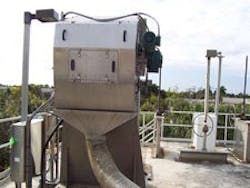Improving Solids Removal at Florida Treatment Plant
With the motto “The Grass is Greener,” it’s not surprising that the city of Plantation, located in a metropolitan area of southern Florida, strives to keep its wastewater treatment plant at the forefront of technology. The plant also supports the city’s ongoing policies for environmental responsibility, water reuse and landfill acceptability.
Plantation’s conventional activated sludge wastewater treatment plant had been experiencing problems with excess debris remaining in the system, resulting in solids clogging the downstream treatment process, such as sludge pumps and aerators.
According to Don Sullivan, Plantation’s supervisor of wastewater operations, “We needed a machine that would recover far more material than what was currently being removed.”
“We evaluated the Finescreen Monster from JWC Environmental in Costa Mesa,” Sullivan said. “Its perforated-plate fine screen offered excellent capture efficiency and fit. It appeared to be suitable for the rugged use and could handle tough solids and debris coming downstream. The Finescreen was also simpler to operate and maintain than the previous machines we had been using.”
The Plantation plant serves a residential population of about 85,000 and has a capacity of 19 million gal per day (mgd) or 830 l/s. On average, the flow at the plant is roughly 13 mgd (570 l/s). Sullivan describes the plant as bordering on large.
“Small towns that serve a few thousand people typically have plants that process a million gallons or so,” he explains. “Large plants serving areas like Metro Dade County or Chicago are at a much higher level.” With Plantation’s size right in the middle at 19 mgd, the equipment needed to be heavy-duty enough to handle the load.
When the Finescreen Monster with StapleGuardTM was installed at the preliminary treatment area, or headworks, the city immediately began benefiting from a higher capture rate of wastewater solids. StapleGuard technology uses 6-mm perforated ultra-high-molecular-weight (UHMW) polyethylene panel screens, so the finescreen captures more solids, such as rags, plastics, latex products, cigarette butts and other unwanted material.
The solids are then lifted to deck level of the screen where a two-stage brushing and wash water system removes the solids from the panels, which are then conveyed to the next part of the system for further processing.
“Our old equipment was removing approximately 50% of the material that needed to be removed. The new Finescreen Monster is removing at least 90% of that material now, an acceptable level,” Sullivan said.
The Finescreen Monster’s continuous band of UHMW panels are attached to heavy-duty stainless steel roller chains—operating much like a continuously moving escalator. The chains track in UHMW guides at the bottom of the screen, eliminating the need for sprockets or bearings submerged in the wastewater flow. The new StapleGuard panels offer several benefits over standard stainless steel panel material.
UHMW panels are highly resistant to abrasion, wear and corrosion and minimize debris from “stapling” (or hair-pinning) onto the panels. Each UHMW panel fits into a stainless steel frame, allowing easy removal or replacement without removing the entire panel assembly from the screen. According to Kenny Oyler, JWC’s director of Monster Separation Systems, optimum removal of debris is important at any wastewater treatment facility.
“By preventing large solids from entering the treatment process, problems associated with plugging up the system are eliminated. The more debris removed in the headworks area, the more efficient the overall plant operation is,” he said.
Installation of the Finescreen Monster was quick and easy, Sullivan said. “It required less than two days for completion. With its completely self-contained design, the unit essentially dropped into place inside the channel.”
